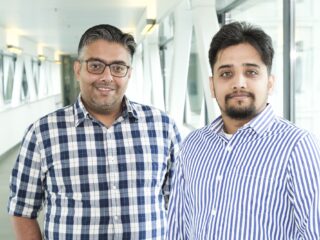Three years ago, the seemingly healthy Tom van Vliet’s life took an unexpected turn when he experienced an epileptic seizure while driving to a party. His partner, Dorien, acted quickly, took over the steering wheel, and managed to bring the car to a stop.
Coincidentally, a nurse from the neurology department of the Groene Hart Hospital was driving behind them. She immediately recognized the seizure and called an ambulance. What followed was a tense weekend in the hospital, where doctors initially suspected a brain tumor, but ultimately determined that the cause of the seizure was an arteriovenous malformation (AVM).
An AVM is a condition where there is a short circuit between the arteries and veins. Because the blood vessels are not formed properly, arterial blood flows directly into the veins under high pressure. In the brain, this can lead to a brain hemorrhage.
Fire department
The hospital’s advice was not to treat the condition. Tom was only prescribed medication to prevent future seizures. Things seemed to go well for a while. Dorien says, “We were making plans to celebrate that things had been fine for a year, when he had another severe seizure, and the fire department had to take him out of the house.” From that point on, Tom started losing confidence in his body. “Every time you feel something, the thought crosses your mind: what’s happening?”
To Treat or Not to Treat the AVM?
Neurosurgeon and chairman of the Dutch Neurovascular Society, Victor Volovici, states that patients with an AVM should always be referred to a specialized hospital. “A neurosurgeon can accurately assess the treatment options and risks and discuss them with other specialists, before providing the patient with a well-considered recommendation.”
A third seizure a few months later led Tom and Dorien to seek treatment options. There were two possibilities: radiation therapy or surgery. In surgery, the faulty connection between the arteries and veins is repaired, reducing the pressure in the brain. However, surgery comes with the risk of damaging healthy brain tissue, and the patient may lose a lot of blood. Radiation therapy, in comparison, poses fewer immediate risks, but it takes several years to know whether the desired result has been achieved.
Terrible headache
An appointment for radiation therapy was already scheduled when Tom suffered a brain hemorrhage last November. What does he remember most about it? Tom says, “I’ve never had such a terrible headache, and I never want to have it again.” He was rushed to Erasmus MC, where he met with neurosurgeons Victor Volovici and Joost Schouten. They discussed the treatment options and were confident that surgery was the way to go. Volovici explains, “We have extensive experience with surgeries for highly complex AVMs. We studied the case thoroughly and developed a plan to eliminate the AVM in one go without causing major side effects.”
And so, Tom and Dorien decided to go ahead with the surgery. Tom recalls, “The memory of that terrible headache, combined with the years of uncertainty that radiation therapy would bring, made it an easy decision.” Dorien adds, “From the moment we decided on the surgery, we were confident that everything would turn out well.”
Ajax
Thankfully, everything did go well. The 10-hour surgery took place on Thursday, and Tom woke up on Friday. The anesthesiologist allowed Tom to call Dorien himself to inform her that the surgery was successful. Tom says, “Beforehand, I had joked: if I wake up and say ‘Ajax,’ send me back, because it means the surgery has completely failed.”
Luckily, his loyalty to his football club wasn’t affected, and the surgery didn’t cause any brain damage. Tom still deals with some lingering effects from the brain hemorrhage. He explains, “I’ve lost a bit of vision, and sometimes it takes two seconds for something to register. I used to be very good at math, but that skill was completely gone after the hemorrhage. Fortunately, it’s starting to come back. I can speak well now, but earlier I struggled to find the right words. Sometimes, I still mix things up.”
Grateful
Tom has now almost fully returned to his normal life. He’s working again, walks two hours a day with the dog to rebuild his stamina, and has even started golfing again. Although, that last part wasn’t easy with impaired vision. He laughs, “The first 4 or 5 times, I confidently swung the club and missed the ball entirely. But now, I’m getting the hang of it again.”

All in all, Tom and Dorien are glad they opted for the surgery. Tom says, “Otherwise, life would still be filled with uncertainty. When would the next seizure or brain hemorrhage happen? I can recommend this step to anyone.”
They now live more consciously after everything they’ve been through. Tom says, “I enjoy both the sun and the rain. Nothing else matters anymore.” Dorien agrees, “The carefree feeling is gone, but we are making plans again. And we focus on what we still have and can do.”
Center for Complex Microvascular Surgery
Erasmus MC is opening an international center for complex surgeries on the smallest blood vessels in the body. Neurosurgeons, ophthalmologists, plastic surgeons, as well as ENT and vascular surgeons, are collaborating to ensure that patients undergoing complex procedures are in the best hands.
Many complex surgeries take place at Erasmus MC each year. One example is the operation on Tom van Vliet’s arteriovenous malformation. It is one of the many intricate and rare procedures that require a high level of skill and expertise, according to neurosurgeon Victor Volovici, one of the initiators of the new center.
How do doctors learn to operate under a microscope in a fast and effective way, and how do they maintain their skills? “Partly by frequently performing the same procedures, and partly by learning from each other, both nationally and internationally,” Volovici says. “But that alone is not enough.” Volovici compares surgery to a sporting event, requiring extensive training to achieve the best results. “But training cannot be the same as the actual event—it has to be different,” says the neurosurgeon.

Neurosurgeon Victor Volovici. Photographer: Esther Morren.
Volovici advocates for more attention to the training process and research into the most effective training programs. “There are only a few centers worldwide looking into this, while more and more is becoming possible with new techniques and technologies.”
Training and maintaining skills are key goals of the center, but there is more. Through the center, Volovici also aims to conduct more research into complex conditions and surgical techniques and to concentrate care for patients requiring complex procedures.
By establishing a center in Rotterdam, with a focus on improving microvascular techniques, Volovici expects to consolidate expertise in the Netherlands and further disseminate it across Europe.



